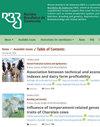Prenatal origins of productivity and quality of beef
IF 1.2
4区 农林科学
Q3 Agricultural and Biological Sciences
Revista Brasileira De Zootecnia-Brazilian Journal of Animal Science
Pub Date : 2022-01-01
DOI:10.37496/rbz5120220061
引用次数: 3
Abstract
- The productive traits of beef cattle are orchestrated by their genetics, postnatal environmental conditions, and also by the intrauterine background. Both under- or overnutrition, as specific dietary components, are able to promote persistent effects on the offspring. This occurs because dietary factors act not only affecting the availability of substrates for fetal anabolism and oxidative metabolism, but also as signals that regulate several events toward fetal development. Therefore, this study aimed to summarize the gestational nutrition effects on the offspring performance and meat quality in a long term. Overall, studies have shown that many of these alterations are under the control of epigenetic mechanisms, as DNA methylation, histones modification, and non-coding RNA. The current knowledge has indicated that the fetal programming responses are dependent on the window of fetal development in which the dietary treatment is applied, the intensity of maternal nutritional stimuli, and the treatment application length. Collectively, studies demonstrated that muscle cell hyperplasia is impaired when maternal requirements were not achieved in the second third of gestation, which limits the formation of a greater number of muscle fibers and the offspring growth potential in a long term. Changes in muscle fibers metabolism and in collagen content were also reported as consequence of a dietary perturbation during pregnancy. In contrast, a maternal overnutrition during the late pregnancy has been associated with beneficial responses on meat quality. In summary, ensuring an adequate maternal environment during the fetal development is crucial to enhance the productive responses in beef cattle operations.牛肉产量和质量的产前起源
-肉牛的生产特性是由它们的遗传、产后环境条件和宫内背景共同决定的。无论是营养不足还是营养过剩,作为特定的饮食成分,都能够促进对后代的持续影响。这是因为饮食因素不仅影响胎儿合成代谢和氧化代谢底物的可用性,而且还作为调节胎儿发育的几个事件的信号。因此,本研究旨在总结妊娠期营养对子代生产性能和肉质的长期影响。总的来说,研究表明,许多这些改变是由表观遗传机制控制的,如DNA甲基化、组蛋白修饰和非编码RNA。目前的知识表明,胎儿编程反应是依赖于胎儿发育的窗口,其中饮食治疗的应用,母体营养刺激的强度,和治疗的应用时间。总的来说,研究表明,在妊娠的后三分之一,当母体的需求没有得到满足时,肌肉细胞增生就会受损,这限制了大量肌肉纤维的形成和后代的长期生长潜力。肌肉纤维代谢和胶原蛋白含量的变化也被报道为怀孕期间饮食紊乱的结果。相反,怀孕后期的产妇营养过剩与肉质的有益反应有关。总之,在胎儿发育期间确保充足的母体环境对于提高肉牛生产反应至关重要。
本文章由计算机程序翻译,如有差异,请以英文原文为准。
求助全文
约1分钟内获得全文
求助全文
来源期刊
CiteScore
1.90
自引率
0.00%
发文量
25
审稿时长
8 weeks
期刊介绍:
The Revista Brasileira de Zootecnia (RBZ; Brazilian Journal of Animal Science) encompasses all fields of Animal Science Research. The RBZ publishes original scientific articles in the areas of Aquaculture, Biometeorology and Animal Welfare, Forage Crops and Grasslands, Animal and Forage Plants Breeding and Genetics, Animal Reproduction, Ruminant and Non-Ruminant Nutrition, and Animal Production Systems and Agribusiness.

 求助内容:
求助内容: 应助结果提醒方式:
应助结果提醒方式:


